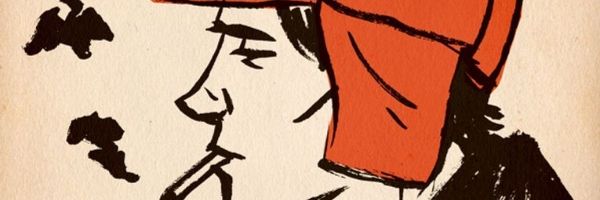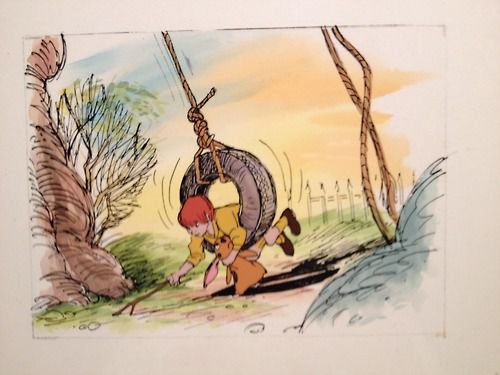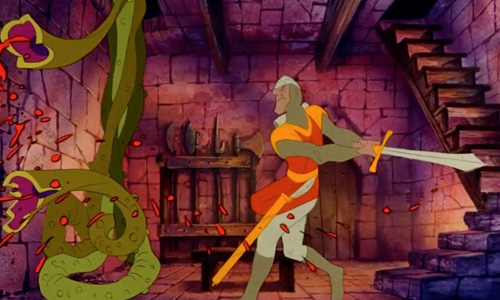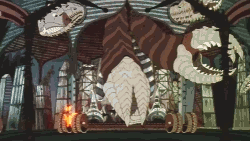Did the infamous Winnie the Pooh videotape Too Smart for Strangers see the light of day under Jim Henson?
You are using an out of date browser. It may not display this or other websites correctly.
You should upgrade or use an alternative browser.
You should upgrade or use an alternative browser.
A Hippie in the House of Mouse (Jim Henson at Disney, 1980)
- Thread starter Geekhis Khan
- Start date
- Status
- Not open for further replies.
Could still do that as a Spirit episode that focuses on the Rocketeer and his cast of characters until the last act or two.Possible, but I like the idea of the Rocketeer being on the trail of some smugglers and getting caught by The Spirit, who's after the same guys. The idea being that the Spirit showing up is a total surprise to everyone, including the audience.
"Might want to do something about that helmet, kid. I could see the shine from the road."
"You! You... You're a legend!"
"Not yet, I'm still waiting for the Happily Ever After."
If I'm not mistaken, A Pup Named Scooby-Doo was going on during that time as well.One name that should come up in the near future is Tom Ruegger who should be working at Hanna-Barbera at this point, but moved to WB Animation in 1989 OTL to produce Tiny Toon Adventures with Spielberg and Amblin Entertainment. Would that change TTL?
Speaking of, I have an idea: either Disney tries to get into the "meddling kids" genre themselves with a Scoobyesque cartoon after seeing Pup's success, or HB attempts to continue riding that gravy train with a new cartoon themselves.
Maybe, maybe not. Speaking of which, I do hope that the likes of Dumbo's Circus and Adventures in Wonderland have better puppetry than they did in our timeline, as it might be too late to save Pooh Corner from being nightmare-inducing.Did the infamous Winnie the Pooh videotape Too Smart for Strangers see the light of day under Jim Henson?
Oddly enough, I have an idea for the concept of "Disney using the Scooby formula". Want me to PM you about it?Speaking of, I have an idea: either Disney tries to get into the "meddling kids" genre themselves with a Scoobyesque cartoon after seeing Pup's success, or HB attempts to continue riding that gravy train with a new cartoon themselves.
Sure.Oddly enough, I have an idea for the concept of "Disney using the Scooby formula". Want me to PM you about it?
A possible Hollywood Pictures film:

 collider.com
I also discovered this:
collider.com
I also discovered this:


Disney Once Considered Making an Animated Catcher in the Rye
Don Hahn, director of the amazing new doc 'Howard,' shares an anecdote from deep within the Disney vault, when they tried to adapt 'Catcher in the Rye.'

Mary Poppins: Brian Sibley's sequel that never was
As a new film depicting the difficult relationship between Walt Disney and Mary Poppins author PL Travers is due for release, writer Brian Sibley reveals he and Travers were approached by Disney to write a sequel.
www.bbc.com
Last edited:

The Velveteen Rabbit (Don Bluth version)
The Velveteen Rabbit was a planned film adaptation of the book of the same name. It was to be directed by Don Bluth and Gary Goldman. A stuffed rabbit is given to a boy as a Christmas present. Through the boy's love, the rabbit begins to desire for a chance to be real. As of right now, there are...

The Velveteen Rabbit
The Velveteen Rabbit was a planned animated film by New Line Cinema on 1987.

The Velveteen Rabbit
The Velveteen Rabbit is one of the animated films that Don Bluth was going to work with Steven Spielberg on, where it is an animation adaptation of the story of a toy rabbit trying to become a real rabbit after his beloved human child owner is forced to abandon him.
I would not be mad at a Disney based Tiny Toons Adventure.One name that should come up in the near future is Tom Ruegger who should be working at Hanna-Barbera at this point, but moved to WB Animation in 1989 OTL to produce Tiny Toon Adventures with Spielberg and Amblin Entertainment. Would that change TTL?
What butterfly effects could the rise of "smart slashers" have on franchises like Alien and Predator, if any, since they had films in production during this time?
And how would Dragon Ball, the series that arguably truly made anime and manga tread into the mainstream, fare ITTL, with Henson taking an interest in the medium?
And how would Dragon Ball, the series that arguably truly made anime and manga tread into the mainstream, fare ITTL, with Henson taking an interest in the medium?
I couid see him perhaps wanting to bring it over to the States, since the action and violence has an over-the-top quality comparable to, say, Bio-Force Five.And how would Dragon Ball, the series that arguably truly made anime and manga tread into the mainstream, fare ITTL, with Henson taking an interest in the medium?
Mr. Bluth goes to Baghdad
Chapter 11: Mr. Bluth Goes to Baghdad
From In the Shadow of the Mouse, Non-Disney Animation 1960-2000, by Joshua Ben Jordan
In 1985 Don Bluth and his team of Disney expatriates were struggling. Despite their herculean effort to keep the costs of The Secret of NIHM at a reasonable $7 million, the animated feature ran headfirst into the juggernaut that was E.T. The Extraterrestrial and earned a moderately profitable, but far from breathtaking, $14.7 million. It wasn’t enough to stave off bankruptcy. The next planned animation project, the Norwegian folk tale East of the Sun and West of the Moon, was cancelled.

Dragon’s Lair, 1983 (Image source “iretron.com”)
In 1983 they launched the Bluth Group. Their Dragon’s Lair videogame, which mixed animation with gameplay, had proven a hit and was soon followed by the similar Space Ace in 1984, but the mid- ‘80s recession in the video game industry proved disastrous, leading to the cancellation of a Dragon’s Lair sequel. Another avenue was needed.
Then, in 1985 they received a call from producer Steven Spielberg of Amblin Entertainment. He and Disney had just formed a partnership with Gary Kurtz and Richard Williams to put Williams’ passion project The Thief and the Cobbler into full production, and they needed animators. Williams was eager to begin, but Disney’s animators were swamped with work on Who Framed Roger Rabbit, Mistress Masham’s Repose, and putting the finishing touches on Where the Wild Things Are, not to mention the several animated TV series and Shorts in production. Spielberg, Kurtz, and Williams showed Bluth and his animators the test footage. Amblin and Disney would give them $24 million ($12 million from each) to make it happen, assuming that Williams would be the lead animator[1]. Though reluctant to give up control to an outsider, times were tough and Bluth and company agreed to do the picture almost immediately.
Bluth, however, took Spielberg aside. “Why would Disney want to work with me?” It was a good question. Some of the older animators remained acrimonious to Bluth and his “traitors”, but Spielberg assured him that Ron Miller, Jim Henson, and the new management harbored no grudges.
“This will be the greatest animated feature ever,” Spielberg assured Bluth, “And your name will be attached to it.” Spielberg also hinted that future projects could be possible[2].
And yet despite Williams’ talent, gaining that promised funding had proven a challenge. Williams’ arch-perfectionism and inability to stay either on schedule or under budget was well known across the industry, and only having the economical Bluth on the team sold the financing partners on the deal (even his Disney detractors admitted that The Secret of NIHM was an amazing accomplishment for under $7 million). The price tag remained a hard sell to investors, though. It was as much as Disney would admit to spending on The Black Cauldron, and The Thief and the Cobbler was hypothetically well into production already. Furthermore, they asked, how could this production cost triple the budget of NIHM? The answer was in the animation, which was being done “on the ones”, meaning that every single frame of the feature was unique as opposed to the much more common and affordable animation done on the “twos”, “threes”, “fours”, or even “sixes”, where frames were reused two to six times in a row. This and William’s excellent eye for drawing in three dimensions made for possibly the smoothest, most lifelike animation yet seen, but it came with a price.

(Image source “tumblr.com”)
In the fall of 1985 Williams and Bluth formed a partnership, with Williams as lead animation director and Bluth as his Vice. The hybrid team immediately set to bringing the picture to life, but almost immediately ran into challenges. The animation produced so far by Williams and his team, including some of Disney’s legendary “9 Old Men”, had been spectacular, but there was no central plot. Two decades of shifting story ideas and changing producers had resulted in a muddled mix of characters and plotlines with random side quests unrelated to the central narrative. And said narrative was weak enough already, in Bluth’s opinion. Bluth, who had a passion for story, almost immediately clashed with Williams, who had his “vision” and was unwilling to kill the set pieces that he loved to save the whole.
As animator Gary Goldman remembered: “It was two deservedly big egos in one very small room. Don and Richard were both passionate about their ideas, and neither took direction very well. John [Pomeroy] and I enlisted Gary [Kurtz] to help straighten out the mess.” Eventually, they came to an understanding where Bluth would take point on story and storyboarding and Williams would take lead on art direction. Gary would be the mediator, or “piggy in the middle” as he soon came to be known. “I remember Gary losing his temper one day and yelling ‘It’s like working with two Georges!’” said Goldman. “I assumed he meant ‘George Lucas’. I’ve honestly never been happier to not be a producer in my life!”
Still, the production continued to struggle along into 1986 with Bluth and Williams almost constantly at each other’s throats and Kurtz still playing “piggy in the middle”. Frank Oz soon found out about the unofficial title and came visiting with Miss Piggy to give Kurtz a hard time. He also asked Kurtz if he’d be interested in a prison visit with Ivan Boesky, which confused Kurtz. “Inside joke,” said Oz.

(Image source “gfycat.com”)
By mid-1986 the animators were well behind schedule and had nearly exhausted their budget despite Bluth’s efforts at cost savings, which inevitably ran headfirst into Williams’ arch-perfectionism. The two argued loudly over Williams’ attempts to throw out entire completed scenes because “the colour is a tad off,” or similar small quality concerns. Still, the available results were breathtaking. “It was like visual poetry,” remembered Jim Henson. “The stairwell scene was magnificent.” Spielberg and Roy Disney expressed similar thoughts. However, Frank Wells was growing increasingly concerned with the schedule and budget overruns, which he reminded Henson and Spielberg were a common thread with Williams, and one that he’d warned them about. Grudgingly, Wells parted with another $7 million. “Make it count,” he said. “There won’t be any more coming from me.”
When Henson and Roy Disney came to Kurtz, his response amounted to “is that it?”
“Gary,” said Henson, “I have Ron’s ear when it comes to art, but he listens to Frank when it comes to money. This is it. It’s sink-or-swim time. I went to the mat for you guys, but if you fail, they may never listen to me again.”
Suitably admonished, Kurtz returned to the project. He gave Williams and Bluth an ultimatum. “The studios are pissed,” he said. “They’re threatening to yank the project and all the cels if we don’t get this mess finished.” Williams was irate and threatened to sue. Kurtz asked him where he’d find the money for the lawyers. With little choice left if he ever wanted to see his film finished, Williams relented.
Saddened, rather than elated, by seeing his belligerent coworker deflated, Bluth invited Williams to dinner. After long hours of venting, there was a coming to terms. “We can do this, Rich,” said Bluth, “like my team did on NIHM, but you’ll need to absolutely trust my judgement.”
Williams hesitated, and agreed. They thus made a pact to finish this project together, on time and within the remaining budget, or go down fighting, side by side.
[1] Recall that in this timeline Roger Rabbit is going into production in ’85, not ’87 as under Eisner, and that Williams is not attached to the project (Zemeckis brought him in to the project in our timeline). Here, Williams is free to pursue Thief & Cobbler. Spielberg is also a part owner in Disney and Associate Board Member.
[2] In our timeline, with Spielberg not involved with Disney but still interested in pursuing animation, he went to Bluth in ’85 with an idea for a partnership. After kicking around a few ideas An American Tail was born.
From In the Shadow of the Mouse, Non-Disney Animation 1960-2000, by Joshua Ben Jordan
In 1985 Don Bluth and his team of Disney expatriates were struggling. Despite their herculean effort to keep the costs of The Secret of NIHM at a reasonable $7 million, the animated feature ran headfirst into the juggernaut that was E.T. The Extraterrestrial and earned a moderately profitable, but far from breathtaking, $14.7 million. It wasn’t enough to stave off bankruptcy. The next planned animation project, the Norwegian folk tale East of the Sun and West of the Moon, was cancelled.

Dragon’s Lair, 1983 (Image source “iretron.com”)
In 1983 they launched the Bluth Group. Their Dragon’s Lair videogame, which mixed animation with gameplay, had proven a hit and was soon followed by the similar Space Ace in 1984, but the mid- ‘80s recession in the video game industry proved disastrous, leading to the cancellation of a Dragon’s Lair sequel. Another avenue was needed.
Then, in 1985 they received a call from producer Steven Spielberg of Amblin Entertainment. He and Disney had just formed a partnership with Gary Kurtz and Richard Williams to put Williams’ passion project The Thief and the Cobbler into full production, and they needed animators. Williams was eager to begin, but Disney’s animators were swamped with work on Who Framed Roger Rabbit, Mistress Masham’s Repose, and putting the finishing touches on Where the Wild Things Are, not to mention the several animated TV series and Shorts in production. Spielberg, Kurtz, and Williams showed Bluth and his animators the test footage. Amblin and Disney would give them $24 million ($12 million from each) to make it happen, assuming that Williams would be the lead animator[1]. Though reluctant to give up control to an outsider, times were tough and Bluth and company agreed to do the picture almost immediately.
Bluth, however, took Spielberg aside. “Why would Disney want to work with me?” It was a good question. Some of the older animators remained acrimonious to Bluth and his “traitors”, but Spielberg assured him that Ron Miller, Jim Henson, and the new management harbored no grudges.
“This will be the greatest animated feature ever,” Spielberg assured Bluth, “And your name will be attached to it.” Spielberg also hinted that future projects could be possible[2].
And yet despite Williams’ talent, gaining that promised funding had proven a challenge. Williams’ arch-perfectionism and inability to stay either on schedule or under budget was well known across the industry, and only having the economical Bluth on the team sold the financing partners on the deal (even his Disney detractors admitted that The Secret of NIHM was an amazing accomplishment for under $7 million). The price tag remained a hard sell to investors, though. It was as much as Disney would admit to spending on The Black Cauldron, and The Thief and the Cobbler was hypothetically well into production already. Furthermore, they asked, how could this production cost triple the budget of NIHM? The answer was in the animation, which was being done “on the ones”, meaning that every single frame of the feature was unique as opposed to the much more common and affordable animation done on the “twos”, “threes”, “fours”, or even “sixes”, where frames were reused two to six times in a row. This and William’s excellent eye for drawing in three dimensions made for possibly the smoothest, most lifelike animation yet seen, but it came with a price.

(Image source “tumblr.com”)
In the fall of 1985 Williams and Bluth formed a partnership, with Williams as lead animation director and Bluth as his Vice. The hybrid team immediately set to bringing the picture to life, but almost immediately ran into challenges. The animation produced so far by Williams and his team, including some of Disney’s legendary “9 Old Men”, had been spectacular, but there was no central plot. Two decades of shifting story ideas and changing producers had resulted in a muddled mix of characters and plotlines with random side quests unrelated to the central narrative. And said narrative was weak enough already, in Bluth’s opinion. Bluth, who had a passion for story, almost immediately clashed with Williams, who had his “vision” and was unwilling to kill the set pieces that he loved to save the whole.
As animator Gary Goldman remembered: “It was two deservedly big egos in one very small room. Don and Richard were both passionate about their ideas, and neither took direction very well. John [Pomeroy] and I enlisted Gary [Kurtz] to help straighten out the mess.” Eventually, they came to an understanding where Bluth would take point on story and storyboarding and Williams would take lead on art direction. Gary would be the mediator, or “piggy in the middle” as he soon came to be known. “I remember Gary losing his temper one day and yelling ‘It’s like working with two Georges!’” said Goldman. “I assumed he meant ‘George Lucas’. I’ve honestly never been happier to not be a producer in my life!”
Still, the production continued to struggle along into 1986 with Bluth and Williams almost constantly at each other’s throats and Kurtz still playing “piggy in the middle”. Frank Oz soon found out about the unofficial title and came visiting with Miss Piggy to give Kurtz a hard time. He also asked Kurtz if he’d be interested in a prison visit with Ivan Boesky, which confused Kurtz. “Inside joke,” said Oz.

(Image source “gfycat.com”)
By mid-1986 the animators were well behind schedule and had nearly exhausted their budget despite Bluth’s efforts at cost savings, which inevitably ran headfirst into Williams’ arch-perfectionism. The two argued loudly over Williams’ attempts to throw out entire completed scenes because “the colour is a tad off,” or similar small quality concerns. Still, the available results were breathtaking. “It was like visual poetry,” remembered Jim Henson. “The stairwell scene was magnificent.” Spielberg and Roy Disney expressed similar thoughts. However, Frank Wells was growing increasingly concerned with the schedule and budget overruns, which he reminded Henson and Spielberg were a common thread with Williams, and one that he’d warned them about. Grudgingly, Wells parted with another $7 million. “Make it count,” he said. “There won’t be any more coming from me.”
When Henson and Roy Disney came to Kurtz, his response amounted to “is that it?”
“Gary,” said Henson, “I have Ron’s ear when it comes to art, but he listens to Frank when it comes to money. This is it. It’s sink-or-swim time. I went to the mat for you guys, but if you fail, they may never listen to me again.”
Suitably admonished, Kurtz returned to the project. He gave Williams and Bluth an ultimatum. “The studios are pissed,” he said. “They’re threatening to yank the project and all the cels if we don’t get this mess finished.” Williams was irate and threatened to sue. Kurtz asked him where he’d find the money for the lawyers. With little choice left if he ever wanted to see his film finished, Williams relented.
Saddened, rather than elated, by seeing his belligerent coworker deflated, Bluth invited Williams to dinner. After long hours of venting, there was a coming to terms. “We can do this, Rich,” said Bluth, “like my team did on NIHM, but you’ll need to absolutely trust my judgement.”
Williams hesitated, and agreed. They thus made a pact to finish this project together, on time and within the remaining budget, or go down fighting, side by side.
[1] Recall that in this timeline Roger Rabbit is going into production in ’85, not ’87 as under Eisner, and that Williams is not attached to the project (Zemeckis brought him in to the project in our timeline). Here, Williams is free to pursue Thief & Cobbler. Spielberg is also a part owner in Disney and Associate Board Member.
[2] In our timeline, with Spielberg not involved with Disney but still interested in pursuing animation, he went to Bluth in ’85 with an idea for a partnership. After kicking around a few ideas An American Tail was born.
This is a great chapter, as always, but...
Does this imply that Fievel and Mickey wouldn't be rivals, but rather, close friends?
Does this imply that Fievel and Mickey wouldn't be rivals, but rather, close friends?
I think this implies An American Tail won't exist ITTL, so it'd be a moot pointThis is a great chapter, as always, but...
Does this imply that Fievel and Mickey wouldn't be rivals, but rather, close friends?
Spielberg also hinted that future projects could be possible[2].
[2] In our timeline, with Spielberg not involved with Disney but still interested in pursuing animation, he went to Bluth in ’85 with an idea for a partnership. After kicking around a few ideas An American Tail was born.
I think it implies that An American Tail may just come out a couple years later than OTL.I think this implies An American Tail won't exist ITTL, so it'd be a moot point
I think this is reasonable. Spielberg might have an 'in' at Disney, but I can readily see him maintaining Amblin Animation so he can pursue the same creative control Henson was after when he joined Disney. This means our beloved Saturday Morning lineups like Tiny Toons, Animaniacs, and Freakazoid! don't have to be butterflied, even if their release dates and specific gags/referential jokes can shift around [1].I think it implies that An American Tail may just come out a couple years later than OTL.
That said, An American Tail takes place in the late 1880s, so Mickey throwing in a line about how one of his grandparents was Russian-Jewish ("Mousekewitz, on my Mother's side") could be a nice nod to the friendship and frequent partnerships between the two studios.
[1] With the very real possibility of Batman: The Animated Series being butterflied, or at least altered, thanks to Disney's The Spirit, the DCAU might begin with Superman instead before broadening out into The Justice League. I'm fine with this since the style of the television DCAU is firmly aligned with Superman and not Batman. It does mean we'd miss out on characters like Harley Quin, Baby Doll (although she'd fit right into The Spirit), and the reimagined Mr. Freeze (although he fits right in as a Justice League antagonist).
Why?With the very real possibility of Batman: The Animated Series being butterflied
@nick_crenshaw82 As I posted before, B:TAS might get butterflied because all its style and thematic elements have been used for The Spirit, which is effectively OTL's Batman a few years early under Disney. It needs to change from OTL's version or it'll risk being seen as terribly derivative of Disney's two-fisted series (they're even set in the same retro-future of the 1940s! I can hear "Bruce Wayne is just Denny Colt in a cape" already). Fortunately if Amblin/Warner Brothers want to make Superman and other DC animated series, then Batman will fit right in, but it'll the Justice League version of Batman and not the retro-40's style of OTL's The Animated Series.
First off it depends on if Timm and Dini were even using that style of animation in the mid 80s. Second as far as I can tell Amblin had nothing to do with Batman OTL. Third it's not very likely that Amblin would work with Warner Bros. considering there close relationship with Disney ITTL, more likely Amblin and Timm and Dini would do a Marvel property (maybe Spider-Man or Captain America). Fourth the bigger thing to butterfly away a Batman animated series is Tim Burton possibly not doing his Batman films, which means people would still see Batman as camp (unless someone else did a serious Batman film.)@nick_crenshaw82 As I posted before, B:TAS might get butterflied because all its style and thematic elements have been used for The Spirit, which is effectively OTL's Batman a few years early under Disney. It needs to change from OTL's version or it'll risk being seen as terribly derivative of Disney's two-fisted series (they're even set in the same retro-future of the 1940s! I can hear "Bruce Wayne is just Denny Colt in a cape" already). Fortunately if Amblin/Warner Brothers want to make Superman and other DC animated series, then Batman will fit right in, but it'll the Justice League version of Batman and not the retro-40's style of OTL's The Animated Series.
- Status
- Not open for further replies.
Share: